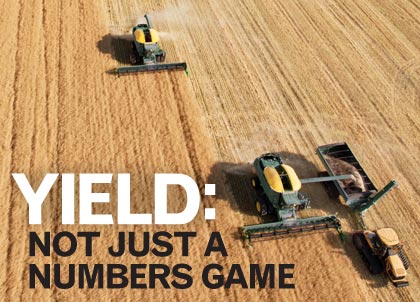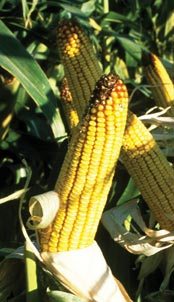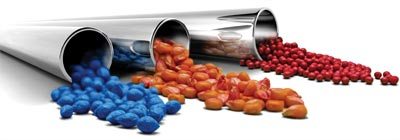A holistic approach to yield management is changing the equation.
Yield may be measured in bushels (or tons) per acre; however, it’s much more than just numbers, as any farmer will probably tell you.
Yield is increasingly viewed as a sum of many factors, whether it’s a crop’s ability to withstand stresses such as drought and heat or the grower’s ability to successfully deal with the pests, weeds and diseases that can affect the amount of grain, fruit or seed that will eventually be harvested.
“The primary definition of yield remains ‘what is harvested from the field in bushels or tons at harvest.’ But how this number is arrived at in terms of input and effort—both physical and, more so, mental in this day and age—is the area we spend a great deal of time on,” says Stephen Denys, vice president of sales and marketing with Pride Seeds of Chatham, Ontario.
“When we look at yield we are looking at ways to increase not only the absolute yield per acre, but the consistency of yield increase over time in a crop. This requires a holistic approach to yield management aimed at taking advantage of the genetic package being planted. Everything producers do throughout the year is really geared toward taking as full advantage as possible of the genetics they plant.”
|
Traits inserted in crops such as corn and soybeans help growers preserve internal yield potential by reducing risks associated with insect and weed pressure. |
Escalating Risks
Today’s farmers, seed companies, agricultural retailers and plant breeders all recognize that many more components make up the term yield now than in the past. “When we thought of yield in the past it was in terms of offensive characteristics in the products that gave them a high yield ability, whereas now farmers are looking for defensive characteristics as much as offensive characteristics in their products because they are looking at being able to limit their risks,” says John Latham of Latham Hi-Tech Seeds, located in Alexander, Iowa.
“The stakes are higher today—inputs are higher, the cost of land is higher, seed costs are higher, and now that markets have gone up too, producers need to be able to limit their risk more than in the past,” he says.
Risk is nothing new to farming, but it seems each passing year brings new and escalating risks: rarely seen pests and diseases, intense and erratic weather events, changing consumer trends and the quality and consistency demands they create from food processors, and fluctuating and increasingly speculative markets.
Proactively dealing with these and other risks is a delicate balancing act, and an important weight factor at one end of the scale is the grower’s choice of purchase, a decision that is now heavily influenced by the risk management package that comes along with the seed.
“From a seed perspective, yield starts with genetics and choosing new varieties that increase yield potential while having inherent characteristics such as standability, disease tolerance, natural drought defense mechanisms, etcetera,” says Denys.
Tools for Success
By using tools such as marker-assisted breeding, the time required to find new and higher-yielding genetics, says Denys, has been shortened. Approaches such as dihaploid breeding have also accelerated and shortened the interval from discovery to commercialization in corn.
“This means producers can take advantage of newer genetics sooner than in the past. In crops like corn and soybeans we have been able to insert traits that help us preserve internal yield potential by reducing the risks associated with insect and weed pressure, and through this preserve yield and quality that can otherwise be jeopardized by secondary diseases that can enter the plant. These are all seed-based technologies internal to the seed,” says Denys.
As more growing areas worldwide are experiencing hotter, dryer conditions in longer cycles than previously seen, drought tolerance is something that producers are asking for in their seed varieties. “Drought tolerance is huge and everyone is looking to get more bushels per acre with less water, whether that’s irrigated or natural,” says Latham.
Specific disease and pest pressure is increasing in many regions and spreading to areas that haven’t traditionally been exposed to them, putting pressure on scientists and plant breeders to stay ahead of the problems. “There are diseases like Goss’ wilt and insects like rootworm in corn that are becoming more of a problem and are even becoming resistant to some technologies,” says Latham. “In our area of northeast Iowa and into northern Illinois, rootworm has become a major problem. There has traditionally been a lot of corn-on-corn, and that has put a lot of pressure on the trait to be able to perform. It can be a serious limiting factor on yield.”
Of equal importance to the genetics of the seed are the treatments that can be applied prior to, at seeding, or in-crop to help protect yield potential as circumstances change in the field.
“In addition to these tools, the industry has focused on and rapidly adopted external seed-based tools including seed treatments to protect the seed through germination, emergence and early plant growth stages,” says Denys. “The impact that the new generation of seed treatments has had on yield potential, stand uniformity and yield consistency cannot be underestimated. Now we see the introduction of third-generation inoculants for crops like soybeans that enhance not only nitrogen fixation, but also enhance natural plant health mechanisms—all applied to the seed by the seed company or retailer to streamline the planting operation and increase the number of acres we can plant per day.”
Seed treatments help protect yield potential as circumstances change in the field.
Back to Basics
However, it’s not just about the science; attending to the basics is vital to getting the most out of the expensive technologies that growers purchase with their seed. “In our discussions with producers, many times we also go back to the basics, which includes creating a seed bed that promotes fast and uniform emergence,” says Denys. “Yes, we have the equipment today to cover more acres faster than ever before, but without these discussions, genetic yield potential is lost at the starting gate if we do not have a good seed bed.”
Seed companies and their retailers, knowing the complexity of the issues that their customers face, are extending their roles to include that of the crop advisor. “Although we are a seed company, in order for our customers to take advantage of the yield potential we are offering, we are working with them to ensure they use a holistic approach to arrive at yield potential, starting with the area we have primary responsibility for, and that is the right choice of genetics combined with internal and external seed-based technologies,” says Denys.
“We have the equipment today to cover more acres faster than ever before, but without these discussions, genetic yield potential is lost at the starting gate if we do not have a good seed bed.”
— Stephen Denys
Production techniques and in-crop treatments are another piece of the yield puzzle. “Beyond seed-based techn
ologies, a holistic approach has lead to research in other key areas, which has led to yield gains and yield consistency gains,” says Denys. “Examples include soil testing and the use of GPS soil mapping, which has increased yield potential across the farm.”
The quest for higher yields to feed and fuel a growing population has also lead to the dramatic growth of in-crop fungicide applications, says Denys. “We see this in crops like corn, where these applications not only preserve yield potential under varying conditions, but preserve plant health, which positively impacts standability at harvest. We are also looking at optimal plant populations, which in many cases are higher than the traditional norm to increase yield potential, something only made possible through the adoption of traits and use of seed treatments and fungicides to reduce other yield-limiting barriers.”
With so much uncertainty year to year, producers want to have access to the best seed available, and to be able to grow the varieties that they consider best for yield potential based on their specific circumstances. However, the same factors that affect next year’s harvest can also affect seed supplies today.
“The more extreme weather, especially the heat and the dry conditions we have seen recently, causes problems for our production and our seed supply,” says Latham. “I think that seed supply is going to be tighter this year across the board for different seed companies because the drought has affected everybody in certain areas and it’s causing all seed companies to go to South America to make up for some of the supply that they have lost in the Midwest this year.”
Latham is encouraging his customers to order early if they want to get the best quality seed and the varieties they want. “We have never had so many orders as we have now for this early in the year. A lot of people are concerned about it and want to make sure they get their supply locked in for next year,” he says.
As farmers consider next year’s crop—with this year’s drought still fresh in their minds—maximizing yield will be a priority. Now is the time to educate growers, helping them connect the dots between the many factors that contribute to yield—managing those within their control and minimizing the ones that aren’t.
Angela Lovell














